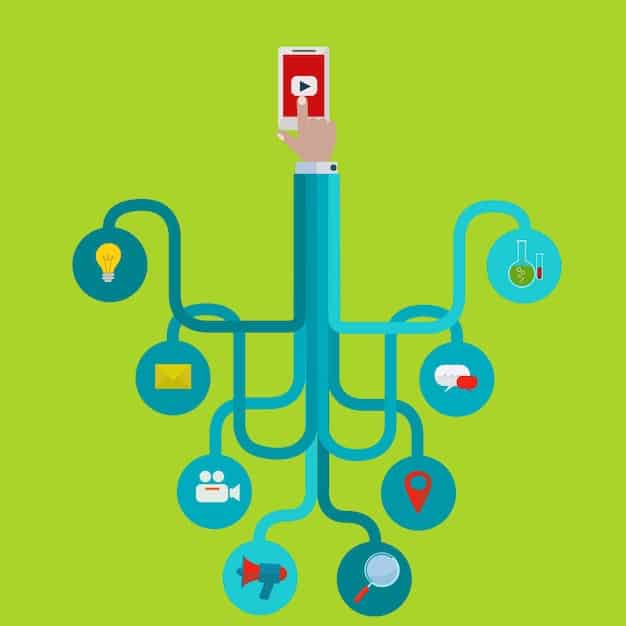US Businesses & $5BN Broadband Grant: Unlocking Growth Opportunities

Seamlessly integrating into the digital fabric of modern commerce, the Unlocking Growth: How US Businesses Can Leverage the New $5 Billion Federal Grant for Broadband Expansion initiative offers an unparalleled opportunity for enterprises across the United States to enhance their operational efficiency, market reach, and overall competitiveness through improved internet access.
The Digital Divide and the Bridge: Understanding the Broadband Initiative
The digital landscape is a cornerstone of modern business, yet a significant portion of the United States still grapples with inadequate internet access. This “digital divide” hinders economic growth, limits educational opportunities, and excludes countless businesses from fully participating in the global marketplace. Recognizing this critical challenge, the U.S. federal government has committed substantial resources to bridge this gap, most notably through a recent $5 billion grant specifically earmarked for broadband expansion. This funding is not merely about providing faster internet; it’s a strategic investment in the nation’s economic future, aiming to create a more equitable and robust digital infrastructure that can support innovation and foster prosperity across all sectors.
The historical context of broadband development in the U.S. reveals a complex tapestry of private investment and public intervention. While major metropolitan areas often boast cutting-edge fiber optic networks, rural and underserved communities have lagged considerably due to the high costs and perceived low returns on investment for private providers. This disparity has profound implications for businesses, particularly small and medium-sized enterprises (SMEs) that rely heavily on online operations, cloud services, and digital marketing to compete. Without reliable, high-speed internet, these businesses face significant disadvantages, limiting their ability to reach customers, manage supply chains, and embrace technological advancements. The new federal grant seeks to directly address these systemic issues, providing the necessary capital to build out critical infrastructure in these forgotten areas.
Bridging Gaps, Boosting Business
The primary objective of this federal grant is to extend high-speed internet access to unserved and underserved areas. This includes rural communities, tribal lands, and even some urban pockets where connectivity remains subpar. For businesses located in or planning to expand into these regions, this investment translates directly into improved operational capabilities. Consider a small agricultural business in a remote area: better broadband means real-time market data, efficient online sales channels, and access to cloud-based precision farming tools. A local artisanal craft shop can now reach a national, or even international, customer base through e-commerce platforms that were previously inaccessible due to slow connections.
The ripple effect of enhanced broadband extends beyond individual businesses. It fosters regional economic development by attracting new businesses, supporting remote work opportunities, and stimulating local economies. When communities gain reliable internet, they become more appealing locations for business investment, leading to job creation and increased tax revenues. This holistic approach recognizes that infrastructure development is not just about wires and towers, but about building resilient and thriving communities capable of adapting to the demands of the 21st-century economy.
The Role of Local Partnerships
Successful implementation of the broadband expansion initiative will heavily depend on collaboration between federal agencies, state and local governments, and private internet service providers (ISPs). This multi-stakeholder approach ensures that funding is deployed effectively, addressing specific local needs while aligning with national strategic goals. Businesses should look for opportunities within these partnerships, perhaps by engaging with local economic development agencies or chambers of commerce to understand how the grants will impact their regions and what role they might play in the evolving digital ecosystem. The strategic deployment of funds through competitive grants to states and tribes ensures that projects are demand-driven and tailored to the unique demographic and geographic characteristics of each target area.
The shift towards digital-first operations, exacerbated by recent global events, underscores the urgency of this investment. Businesses that can adapt and thrive in a connected world will be those that have access to robust broadband. This grant acts as a powerful catalyst, providing the financial impetus to accelerate this transition and ensure that no business is left behind due to a lack of fundamental digital infrastructure. It’s an opportunity for businesses to embrace new technologies, innovate operational processes, and secure their place in an increasingly digital global market.
Navigating the Grant Landscape: Eligibility and Application Insights
Accessing federal grants can often seem like a labyrinthine process, but for businesses looking to leverage the $5 billion broadband expansion fund, understanding the core eligibility requirements and application insights is paramount. This grant is primarily aimed at infrastructure development, meaning that the direct beneficiaries are typically internet service providers, municipalities, tribal entities, and non-profit organizations that are constructing or upgrading broadband networks. However, businesses can indirectly benefit by collaborating with these entities or by positioning themselves to take advantage of the improved infrastructure once it’s in place.
The federal grant programs generally prioritize projects that demonstrate a clear need, propose a sustainable business model, and commit to delivering high-speed, affordable service to unserved or underserved areas. For businesses, this means understanding which areas are designated as high-priority and how their operations or expansion plans align with the goals of connecting these communities. It’s not about directly applying for funds to upgrade your office internet connection, but rather about understanding how the broader ecosystem of broadband development can support your strategic objectives.
Who is Eligible? Decoding the Details
While the specific grant programs under the $5 billion umbrella may have slightly varied criteria, the overarching eligibility typically targets entities capable of deploying and maintaining broadband infrastructure. These include:
* Internet Service Providers (ISPs): Both established and emerging ISPs, often those with a proven track record or innovative deployment strategies.
* Local and State Governments: Municipalities, counties, and state agencies that are spearheading community broadband initiatives.
* Tribal Governments: Sovereign tribal nations seeking to enhance connectivity on their lands.
* Non-Profit Organizations: Groups with a mission to serve specific communities through digital inclusion efforts.
* Public-Private Partnerships (PPPs): Collaborations between public entities and private companies to achieve shared connectivity goals.

The eligibility criteria often delve into technical specifications (e.g., minimum download/upload speeds provided), financial stability of the applicant, and community engagement plans. For businesses considering an indirect approach, aligning with an eligible entity that is applying for a grant could be a strategic move. This could involve offering local input, demonstrating potential demand for services, or even forming formal partnerships where appropriate.
Key Application Insights for Indirect Benefit
For a business not directly eligible to apply, influencing or benefiting from these grants requires a different approach:
* Understand Local Needs: Research which unserved or underserved areas are relevant to your business operations or target markets.
* Engage with Potential Applicants: Reach out to local ISPs, economic development agencies, or municipal planning departments to understand their plans and express your business’s needs for enhanced connectivity.
* Form Coalitions: Collaborate with other local businesses to present a unified front on the importance of broadband to your regional economy. This collective voice can strengthen grant applications from eligible entities.
* Stay Informed on Project Timelines: Monitor announcements regarding awarded grants and project timelines to anticipate when improved services will become available in your area.
* Prepare for Adoption: Once new infrastructure is in place, be ready to upgrade your services, integrate new technologies, and leverage the full potential of high-speed internet.
The application process itself is rigorous, often requiring detailed technical proposals, financial projections, and environmental reviews. While businesses won’t typically be filling out these forms, understanding the depth of information required helps calibrate expectations and highlight the commitment federal agencies demand for these significant investments. The insight here is to be a proactive stakeholder, not a passive bystander, in the broadband expansion journey within your operational vicinity.
Strategic Business Opportunities: Beyond Basic Connectivity
The influx of $5 billion for broadband expansion fundamentally reshapes the technological landscape for US businesses, extending far beyond simply providing basic internet access. This investment opens up strategic opportunities for innovation, market expansion, and operational transformation that astute businesses can capitalize on. It’s about leveraging newfound connectivity to implement advanced digital strategies that drive growth and competitiveness.
The enhanced infrastructure will enable businesses to fully embrace technologies that were previously out of reach due to bandwidth limitations or latency issues. This includes widespread adoption of cloud computing, real-time data analytics, sophisticated e-commerce platforms, and advanced communication tools. For many businesses, particularly those in rural or underserved areas, this represents a quantum leap in their operational capabilities, putting them on a more level playing field with their urban counterparts.
Embracing Cloud-First Operations
With reliable high-speed broadband, businesses can confidently migrate more of their operations to the cloud. This isn’t just about data storage; it encompasses everything from enterprise resource planning (ERP) systems and customer relationship management (CRM) software to project management tools and remote collaboration platforms. Cloud adoption offers several benefits:
* Scalability: Easily scale IT infrastructure up or down based on business needs, avoiding costly hardware investments.
* Cost Efficiency: Reduce expenditures on on-premise servers, maintenance, and power.
* Flexibility: Enable remote workforces and distributed teams to access critical applications and data from anywhere.
* Security: Benefit from the robust security measures often implemented by major cloud providers.
For example, a manufacturing firm can leverage cloud-based IoT (Internet of Things) platforms to monitor production lines in real-time, optimizing efficiency and predicting maintenance needs. A consulting firm can use cloud-native video conferencing and document sharing tools to facilitate seamless collaboration with clients and remote consultants, regardless of their geographical location.
Expanding E-commerce and Digital Marketing Reach
Improved broadband parity means a larger, more engaged online audience. Businesses can significantly enhance their e-commerce capabilities and digital marketing efforts.
* Rich Media Content: Stream high-definition video, host interactive virtual tours, and utilize advanced AR/VR experiences to showcase products and services.
* Faster Website Loading: Ensure optimal user experience with quick loading times, crucial for retaining customer interest and improving SEO rankings.
* Targeted Digital Campaigns: Leverage robust data analytics to run highly targeted advertising campaigns that reach specific demographics within newly connected communities.
* Global Market Access: Small businesses, once limited to local foot traffic, can now realistically pursue national and international sales through sophisticated online storefronts.
Consider a boutique clothing store in a small town. With better broadband, they can flawlessly host live online fashion shows, process high volumes of international orders, and engage with influencers globally, transforming their local appeal into a worldwide presence.
Unlocking Telemedicine, Remote Education, and Distributed Workforces
The shift towards more flexible work models and decentralized service delivery is accelerated by robust broadband.
- Telemedicine & Healthcare Innovations: Rural clinics can offer remote consultations, enabling specialists to reach patients regardless of distance, and facilitating the secure transfer of large medical image files.
- Remote Education & Training: Businesses can provide extensive online training programs for employees, partners, and even customers, fostering skill development and knowledge transfer.
- Distributed Workforces: Companies can tap into a wider talent pool, hiring employees from across the country without geographical constraints, leading to improved diversity and reduced overhead costs for office space.
This expanded connectivity drives not just operational improvements but also opens up new revenue streams and business models based on digital service delivery. Businesses that strategically plan for and invest in these advanced applications will be the ones that truly unlock the growth potential offered by this federal initiative.
Ensuring Equity and Sustainability: Long-Term Impact and Challenges
The federal government’s $5 billion grant for broadband expansion is a significant step towards closing the digital divide, but its long-term impact hinges on ensuring equity and sustainability. Building the infrastructure is only part of the challenge; ensuring that it remains accessible, affordable, and relevant for all communities, particularly underserved ones, is equally vital. Businesses have a vested interest in the equitable distribution of these resources, as it directly impacts their potential customer base, workforce availability, and supply chain resilience.
The concept of digital equity encompasses not just access to broadband, but also access to affordable devices, digital literacy skills, and relevant online content and services. Without these complementary elements, even the fastest internet connection can fail to deliver its full societal and economic benefits. Therefore, businesses looking to capitalize on this expansion should also consider how they can contribute to or benefit from initiatives that address these broader aspects of digital inclusion.
Addressing Affordability and Accessibility
One of the primary challenges moving forward will be ensuring that high-speed internet is not only available but also affordable for all households and businesses. The grant programs often include provisions or incentives for ISPs to offer low-cost plans, but sustained affordability requires ongoing policymaking and market regulation. Businesses can play a role by:
* Advocating for Affordable Plans: Support policies that promote competitive pricing and subsidies for low-income users within newly connected areas.
* Offering Digital Literacy Training: Partner with local schools or non-profits to provide basic computer and internet skills training, ensuring potential customers and employees can effectively utilize broadband services.
* Designing Inclusive Digital Services: Develop platforms and services that are user-friendly, even for those with limited digital experience, and accessible across various devices.
* Investing in Local Digital Hubs: Support community centers or libraries that provide public access to computers and internet, acting as vital bridges for those who cannot afford in-home connectivity.
The goal is to prevent a scenario where infrastructure is built but remains out of reach for a significant portion of the population, thereby limiting its economic impact.
Maintaining Infrastructure and Adapting to Future Needs
Broadband infrastructure requires continuous maintenance, upgrades, and adaptation to evolving technological demands. The initial $5 billion grant kickstarts deployment, but sustainable growth will depend on ongoing investment and prudent management. Key considerations include:
* Future-Proofing: Ensuring that newly deployed networks are designed to accommodate future bandwidth needs and technological advancements, rather than quickly becoming obsolete.
* Operational Sustainability: Developing clear plans for funding ongoing maintenance and operational costs of the new networks. This often involves a mix of user fees, local government contributions, and potentially further federal or state support.
* Mitigating Environmental and Social Impacts: Ensuring broadband deployment is carried out responsibly, minimizing ecological disruption and respecting community concerns.
* Cybersecurity Resilience: Building robust cybersecurity measures into new networks to protect against threats and ensure data integrity, a critical concern for businesses operating online.
For businesses, recognizing these long-term challenges is crucial for strategic planning. It means looking beyond the immediate benefit of improved connectivity and considering the stability and longevity of the digital infrastructure they will come to rely upon. Engaging with local planning commissions and utility providers can offer insights into these long-term strategies and potential vulnerabilities.
The federal grant represents a powerful accelerator for digital transformation, but its ultimate success will be measured by its ability to foster truly equitable and sustainable connectivity across the US. Businesses that actively participate in these broader discussions and initiatives will not only secure their own digital future but also contribute to the economic vitality of the communities they serve.
Case Studies and Success Stories: Real-World Broadband Impact
Examining real-world examples can provide invaluable insights into how enhanced broadband connectivity translates into tangible benefits for businesses and communities. While the new $5 billion federal grant is still in its early stages of distribution and implementation, lessons can be drawn from previous federal, state, and private broadband initiatives that have successfully transformed underserved regions. These case studies highlight diverse applications, from boosting agricultural efficiency to revitalizing town centers through digital commerce.
The consistent theme across these success stories is the catalytic effect of robust internet access on local economies. It’s not just about enabling existing businesses to operate more efficiently, but also about fostering entirely new economic activities and attracting outside investment, demonstrating a clear return on the infrastructure investment. These narratives showcase the inventive ways businesses have leveraged improved connectivity to innovate, grow, and create jobs.
Revitalizing Rural Appalachia: The Fiber Optic Advantage
In a region of rural Appalachia, a previous state-funded initiative brought fiber optic broadband to several previously unserved counties. Before the connectivity upgrade, local businesses, primarily small retail and service shops, struggled with slow and unreliable internet, limiting their ability to process credit card transactions efficiently, manage online inventory, or engage in any meaningful e-commerce.
* The Transformation: Within two years of fiber deployment, local businesses reported a significant increase in online sales, with some expanding their reach nationally. A small furniture maker, for instance, used to rely solely on local custom orders but now ships bespoke pieces across the country after developing a sophisticated e-commerce site.
* New Opportunities: The improved internet also attracted remote workers and digital nomads, who found the combination of rural charm and urban-level connectivity appealing. This influx led to a demand for new local services and spurred growth in the hospitality sector, demonstrating how connectivity can diversify an economy.
* Educational Gains: Local schools and libraries were able to offer more advanced digital learning resources, leading to a more digitally literate local workforce, another indirect benefit for businesses seeking skilled employees.
This example illustrates how foundational broadband infrastructure can trigger a virtuous cycle of economic development, drawing in revenue and talent that were previously inaccessible.
Precision Agriculture in the Midwest: Data-Driven Farming
A significant challenge for modern agriculture is the collection and analysis of vast amounts of data—from soil conditions to weather patterns and crop yields. In certain Midwest farming communities, limited broadband had prevented the widespread adoption of precision agriculture technologies.
* Connectivity as an Enabler: A collaborative effort between local governments and an agricultural co-operative, backed by a federal pilot program, expanded broadband access to key farmlands. This allowed farmers to deploy IoT sensors in fields, collect real-time data, and utilize cloud-based analytics platforms.
* Enhanced Efficiency: Farmers could now precisely apply fertilizer, monitor irrigation systems remotely, and even use drone technology for crop health assessments, leading to reduced waste, higher yields, and significant cost savings. One large-scale farm reported a 15% increase in yield for a key crop due to optimized resource management.
* Supply Chain Optimization: Better connectivity also streamlined communication with suppliers and distributors, reducing delays and improving overall supply chain efficiency. Farmers could access market prices in real-time, making more informed decisions about when and where to sell their produce.
This case clearly shows how broadband moves beyond basic communication to become an essential tool for sophisticated, data-driven industries, enhancing productivity and profitability.
Small Business Innovation in Underserved Urban Areas
While often associated with rural areas, digital deserts can exist even within bustling cities. In a lower-income neighborhood of a major metropolitan area, a grant-funded community broadband network transformed local small businesses.
* Digital Transformation: A local non-profit worked to help small businesses – from barbershops to local restaurants – integrate online booking systems, implement touchless payment solutions, and develop basic e-commerce sites. Before, many relied solely on cash transactions and walk-ins.
* Increased Revenue: The ability to accept online orders and credit card payments led to an immediate increase in sales for many establishments. A small bakery, for example, saw its customer base expand significantly by offering online pre-orders for daily specials and custom cakes.
* Community Empowerment: Beyond business, the broadband access enabled residents to access online government services, educational resources, and telehealth appointments, creating a more connected and empowered community that, in turn, supported local businesses with increased digital literacy.
These diverse examples underscore the transformative power of broadband expansion. For the $5 billion federal grant, they serve as a blueprint, demonstrating that strategic investment in connectivity provides a robust foundation for long-term economic growth across various sectors and geographies. Businesses should look to these previous successes for inspiration and best practices as they prepare to leverage the upcoming opportunities.
Preparing Your Business: Actionable Steps for the Broadband Future
The upcoming improvements in broadband infrastructure present a critical juncture for US businesses. While the $5 billion federal grant is primarily for infrastructure development, forward-thinking businesses must take proactive steps to leverage this investment into tangible growth opportunities. Ignoring this transformation risks being left behind in an increasingly digital economy. Preparedness isn’t just about having faster internet; it’s about re-evaluating core operations, strategic planning, and fostering a digital-first mindset across the organization.
The time to prepare is now. Businesses should conduct internal audits of their current digital capabilities, identify areas where improved connectivity can unlock new efficiencies or revenue streams, and begin to explore potential partnerships or training initiatives. This strategic foresight will ensure that once high-speed broadband becomes widely available, your business is not just ready to connect, but ready to thrive.
Step 1: Assess Current Digital Infrastructure and Needs
Before you can leverage new opportunities, you need a clear picture of your current state.
* Conduct a Connectivity Audit: Evaluate your current internet speed, reliability, and cost. Understand bandwidth usage during peak hours and identify bottlenecks.
* Identify Digital Gaps: What technologies or services are you currently unable to fully utilize due to connectivity limitations? (e.g., cloud analytics, large file transfers, advanced video conferencing).
* Survey Employee Needs: Understand how employees currently use the internet for work and what their pain points are. Remote teams, in particular, will benefit from improved home broadband.
* Evaluate Hardware and Software Readiness: Is your existing hardware (routers, networks, devices) capable of handling higher speeds? Are your software licenses up-to-date for cloud-based applications?
This assessment should provide a roadmap for internal upgrades and highlight specific areas where improved broadband can yield the greatest returns.
Step 2: Explore Potential Partnerships and Local Initiatives
While you won’t directly apply for the $5 billion grant, strategically engaging with applying entities can be highly beneficial.
* Connect with Local ISPs: Inquire about their plans for expanding service in your area and whether they are applying for federal grants. Express your business’s needs and potential for increased service adoption.
* Liaise with Local Government & Economic Development Agencies: These entities are often involved in grant applications and community broadband planning. Offer your insights as a business stakeholder and stay informed about local projects.
* Join Business Associations: Chambers of commerce or industry-specific associations often advocate for business needs and can be a source of information about local broadband initiatives.
* Consider Community Engagement: Participate in public forums or surveys related to broadband expansion. Your voice as a business owner or leader carries weight.
These relationships can provide early access to information about new infrastructure deployment and potentially influence its rollout to best suit local business needs.
Step 3: Invest in Digital Skill Development and Cybersecurity
Having the pipes is one thing; knowing how to use them effectively and securely is another.
* Digital Literacy Training: Provide training for your employees on leveraging new digital tools and platforms. This could include cloud software, advanced e-commerce functionalities, or data analytics basics.
* Cybersecurity Protocols: With increased connectivity comes increased vulnerability. Review and strengthen your cybersecurity measures, including employee training on phishing, secure passwords, and data protection best practices.
* Explore New Technologies: Research how next-generation technologies like AI, machine learning, and advanced IoT can be integrated into your operations once robust broadband is available. Even small exploratory projects can yield significant insights.
The transition to a highly connected environment requires both technological readiness and a digitally skilled workforce. Proactive investment in both will ensure your business is not just connected, but also innovative and resilient in the new broadband landscape.
| Key Area | Benefit for US Businesses |
|---|---|
| 🚀 Connectivity Expansion | Access to high-speed internet in previously underserved areas, enabling broader market reach and operational efficiency. |
| ☁️ Cloud & Digital Adoption | Facilitates migration to cloud-based tools, enhancing scalability, reducing IT costs, and supporting remote workforces. |
| 📈 Market Growth | Boosts e-commerce capabilities, enabling wider customer engagement, targeted digital marketing, and access to new markets. |
| 🤝 Strategic Partnerships | Opportunities to collaborate with ISPs, local governments, and community groups, influencing infrastructure development. |
Frequently Asked Questions
▼
The $5 billion federal grant is a significant funding initiative by the U.S. government aimed at expanding high-speed internet access to unserved and underserved areas across the United States. Its primary goal is to bridge the digital divide, stimulate economic growth, and ensure equitable connectivity for all communities and businesses.
▼
Generally, direct applicants for these infrastructure grants are entities responsible for deploying and maintaining broadband networks, such as internet service providers (ISPs), municipalities, tribal governments, and non-profit organizations. Businesses typically benefit indirectly by leveraging the expanded infrastructure once it’s in place, or by partnering with eligible applicants.
▼
Improved broadband enables small businesses to enhance e-commerce capabilities, access cloud-based software, expand remote work options, utilize real-time data analytics, and streamline supply chain management. It also opens new avenues for digital marketing and allows for more stable and efficient communication with customers and partners, fostering overall growth.
▼
Strategic opportunities include the ability to fully adopt cloud-first operational models, expand into new digital markets previously inaccessible, innovate with data-driven technologies like IoT and AI, and attract or retain talent through robust remote work frameworks. It essentially levels the playing field for businesses in terms of digital capabilities.
▼
Businesses should assess their current digital infrastructure and needs, explore potential partnerships with local ISPs and government entities involved in the rollout, and invest in digital skill development for employees. Strengthening cybersecurity protocols is also crucial to safeguard operations in an increasingly connected environment.
Conclusion
The new $5 billion federal grant for broadband expansion represents a pivotal moment for US businesses, transcending mere technological upgrade to become a powerful catalyst for economic transformation. This monumental investment will reshape the digital landscape, leveling the playing field for enterprises in underserved areas and unlocking unprecedented growth opportunities across all sectors. By embracing the improved infrastructure, strategically adopting cloud technologies, enhancing digital marketing efforts, and fostering talent through digital literacy, businesses can not only survive but thrive in the evolving global market. The future of commerce is inextricably linked to robust connectivity, and this grant provides the essential foundation for American businesses to build a more dynamic, resilient, and inclusive digital economy.





